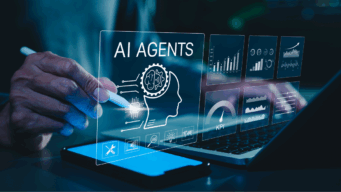On October 14–15, 2025, OpenText brought together global business leaders, engineers, and innovators for Connected Realities: An IoT Innovation Summit, a two-day virtual event exploring how Artificial Intelligence (AI) and Internet of Things (IoT) are converging to create trusted, predictive, and intelligent operations.
Hosted across two focused tracks—Traceability in Motion (Day 1) and Predictive & AI-Driven Operations (Day 2) which showcased live demos, real-world customer stories, and expert discussions on what’s next for the use of AI in digital supply chains, manufacturing, and asset intelligence.
Access session replays and related resources on ours IoT Platform & Traceability page.
Day 1 — Traceability in motion: building trust in a connected world
Keynote — Traceability in motion: the new language of trust
Speaker: Richard Lightfoot, OpenText
Richard Lightfoot pointed out that traceability has never been more important for companies or society as we know them today. He had several major challenges to address, including trillions in counterfeit and grey-market goods. According to an IBM study, 79% of consumers demand transparency and authenticity. Counterfeit goods may adversely affect business performance, tarnish brand credibility, compromise consumer safety and trust, and endanger company performance. He showed serialized data and smart data from the OpenText Core Product Traceability Service (CPTS). Combining serial data, AI analytics, and workflows, the product knowledge is across a single source of truth. This helps organizations maintain trust, safety, and continuous business, which benefits their overall corporate responsibility.
Key Takeaways:
- Fragmented organizations and manual compliance build brand risk; CPTS provides real-time, end-to-end visibility.
- Traceability fuels sustainability and profit by enabling reuse, precision recall, and recycling insight.
- The next generation of brand value is based on data-validated authenticity.
Customer Spotlight — YETI: serialization & traceability in manufacturing quality reimagined
Guest: Nkere Eneyo, Manufacturing Engineering Manager, YETI
Moderator: Richard Lightfoot, OpenText
YETI centralized more than 40 key partners under a single quality system, serializing every product, case, and pallet, and creating a reliable warranty registration system. It has integrated it so that everyone can trust each YETI product, improve anti-counterfeit measures, and build post-purchase engagement through a reliable warranty registration system. Such an initiative resulted in measurable improvements in quality assurance and brand trust, and even set new, trackable industry standards.
Highlights:
- Serialization (assigning unique IDs) captures lots, suppliers, production lines, and QC (quality control) attributes during the entire process.
- Digital registration extends the customer relationship beyond the sale.
- Traceability is not just compliance—it’s a brand promise and innovation engine.
- “Think of partners as something on the extension of your quality system — traceability is the thread of shared trust.”
Fireside — Integration Leadership in the Age of Connected Intelligence
Guest: Jonathan Cullender, Senior Manager – Automation, PowerPlatforms & Integration Technologies, Shell
Moderator: Steve Dale, OpenText
Shell has been a long-standing global partner of OpenText, collaborating across decades, from foundational EDI connectivity to cutting-edge product track-and-trace initiatives. Their journey has delivered several industry firsts that continue to shape how modern supply chains operate and scale.
In this session, Jonathan shared how Shell’s culture of innovation and integration leadership enables agility across its vast, global ecosystem. He discussed how integration is evolving in the age of AI and IoT, as organizations shift from isolated edge pilots to enterprise-wide orchestration.
Key themes included:
- Integration as an enabler of intelligence: From connecting systems to enabling autonomous decisions.
- Real-time data readiness: Moving beyond lagging metrics to live, actionable insights.
- Scaling governance and culture: Lessons from Shell’s global modernization journey.
- Future of integration: How AI-driven, agentic systems will redefine collaboration across business and technology teams.
Watch this conversation and other Day 1 highlights on the IoT Platform & Traceability Hub.
Day 2 — Predictive & AI-driven operations: from data to foresight
Opening remarks — Mark Morley, OpenText
Mark discussed how IoT platforms exemplify the evolution from slow growth to cloud-native orchestration and AI-powered solutions. He brought Agentic IoT into being, integrating data, context, and independent action. For instance, today, a wind turbine can self-schedule, predict failures, and coordinate repair operations without human intervention, using real-time data. This is an example of how Agentic IoT transforms data into insights and actionable actions in an intelligent manner.
Fireside Chat — From data to foresight: Building the predictive excellence pyramid
Speakers: Tom Clement, OpenText | Chris Kopp, Host Great Practices Podcast
Tom outlined the five foundational building blocks of IoT operations.
- Identity Management: Securing access with SSO/MFA.
- Scalable data processing: Monitoring millions of assets for predictive uptime.
- Transaction & incident management: Enabling instant anomaly response.
- Turnkey ingestion: Scaling networks without re-engineering data pipelines.
- Data & application integration: Embedding IoT insights into enterprise context.
Their dialogue emphasized that predictive excellence depends on data foresight (anticipating future events), not just data volume, by turning signals into coordinated, explainable actions. They discussed how the Aviator IoT platform delivers explainable intelligence through its AI capabilities and Digital Twin Synchronization (a digital copy of a physical asset that stays up to date).
Panel Discussion — Agentic IoT: from reactive data to autonomous decisions
Speakers: Eric Thomson (IRISS) | Cameron Redovian (R-DEX Systems) | Tom Clement (OpenText)
Moderator: Dipalli Bhatt, OpenText
The summit ended with a forward-looking dialogue on Agentic IoT and how AI-driven agents can safely perceive, reason, and act on trusted IoT data. As moderator, I framed this as the next leap beyond predictive analytics, where GenAI reasoning works with human-in-the-loop control.
Eric Thomson noted that cloud maturity and GenAI have made autonomy viable at scale, while Tom Clement shared how customers now ask for measurable outcomes—uptime, safety, and compliance—rather than “IoT platforms.” Cameron Redovian demonstrated how sensor fusion and anomaly detection can trigger automated maintenance actions with human approval, showcasing OpenText–R-DEX collaboration.
The panel agreed that trustworthy data foundations, safe autonomy, and open ecosystems are essential. The discussion around the 90-day “Agent-in-a-Box” highlighted pilots spanning facility uptime to cold-chain compliance, showing how enterprises can start small, prove value, and scale fast.
“Agentic IoT rewards integration, not reinvention,” Clement summarized. “It’s how AI turns connected operations into autonomous, explainable outcomes.”
Watch the replay and explore related assets on the IoT Platform & Traceability Hub.
Summit Takeaways
- Traceability and predictive intelligence now form the backbone of trusted digital operations.
- Agentic IoT defines the next phase with systems that can sense, reason, act, and learn.
- OpenText continues to bridge the gap between visibility and action, data and decision.
Continue the Journey
Explore session recordings, best-practice guides, and demos on the IoT Platform & Traceability Resource Hub.



